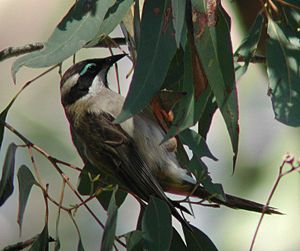Black-chinned honeyeater facts for kids
Quick facts for kids Black-chinned honeyeater |
|
|---|---|
 |
|
| Conservation status | |
| Scientific classification | |
| Genus: |
Melithreptus
|
| Species: |
gularis
|
| Synonyms | |
|
Melithreptus laetior (Gould, 1875) |
|
The black-chinned honeyeater (scientific name: Melithreptus gularis) is a type of passerine bird. It belongs to the honeyeater family, called Meliphagidae. This bird lives only in Australia, which means it is endemic there. There are two main kinds, or subspecies, of the black-chinned honeyeater. You can find them in temperate forests and dry tropical forests.
Contents
About the Black-chinned Honeyeater's Name
The black-chinned honeyeater was first described by a scientist named John Gould in 1837. He gave it the name Haematops gularis. Later, he also described a bird he called the golden-backed honeyeater in 1875. This bird lived in northern Australia.
Scientists later realized that these two birds were very similar. In 1975, they decided they were actually the same species. They are now known as two different types, or subspecies, of the black-chinned honeyeater. More research is still being done to learn about their differences.
The black-chinned honeyeater is part of a group of birds called Melithreptus. Many birds in this group are similar in size. Most of them also have black heads, except for the brown-headed honeyeater. These birds are all part of the honeyeater family.
Scientists have found that the black-chinned honeyeater is most closely related to the brown-headed honeyeater. These birds have short, strong feet. They often gather in small groups. They prefer to live in forests. They look for insects by probing in the bark and branches of trees.
What Does the Black-chinned Honeyeater Look Like?
This is a medium-sized honeyeater. It is about 14 to 16 centimeters (5.6 to 6.4 inches) long. Its back is olive-brown, and its belly is a pale yellowish-brown. It has a black head, neck, and throat.
Around its eye, there is a patch of bare bluish skin. It also has a white patch on the back of its neck that looks like a crescent moon. Its legs and feet are orange. Young black-chinned honeyeaters are mostly brown.
This bird makes a scratchy sound that goes creep-creep-creep. It also has a more musical call. Birds from different parts of Australia can look slightly different. For example, some have more yellow on their upper parts.
The golden-backed subspecies looks a bit different. It has a yellow neck and rump. Its back is green-yellow. The black patch on its chin is smaller. Its chest is more grey-white than yellowish-brown. Its sides and belly are white. Its wings are lighter brown, and its tail feathers have green edges. The bare skin around its eyes is yellow-green.
Where Do Black-chinned Honeyeaters Live?
The black-chinned honeyeater lives across northern Australia. You can find it in northwest Western Australia, including the Kimberley region. It also lives in the Top End and Gulf Country. Its range extends to Cape York in Queensland. It is found across central and eastern Queensland. You can also see it in central New South Wales.
It lives east of the Great Divide in New South Wales. However, it is rare further south, especially around Sydney. It is also found in central and northern Victoria. You can see it in eastern South Australia too.
This bird is considered vulnerable in New South Wales and South Australia. This means its numbers are decreasing in those areas. However, its overall population is stable. It lives in open woodlands and dry forests. They often live near rivers or streams.
What Do Black-chinned Honeyeaters Eat?
Black-chinned honeyeaters mainly eat insects. Like its relatives, the brown-headed and strong-billed honeyeaters, it finds food in a special way. It probes into the bark of tree trunks and branches. This is how it finds insects hidden there.
How Do Black-chinned Honeyeaters Raise Their Young?
Black-chinned honeyeaters can build nests and lay eggs from July to December. They might breed once or twice during this time. Their nest is shaped like a thick-walled bowl. They build it using grasses and small pieces of bark. Inside, they line it with softer plant materials.
They usually hide their nest in the outer leaves of a tall tree. Eucalyptus trees are a common choice. They lay one or, more often, two eggs. The eggs are about 22 by 16 millimeters in size. They are shiny and have a buff-pink color. They have a few red-brown spots, especially on the larger end.
See also
 In Spanish: Mielero barbinegro para niños
In Spanish: Mielero barbinegro para niños



